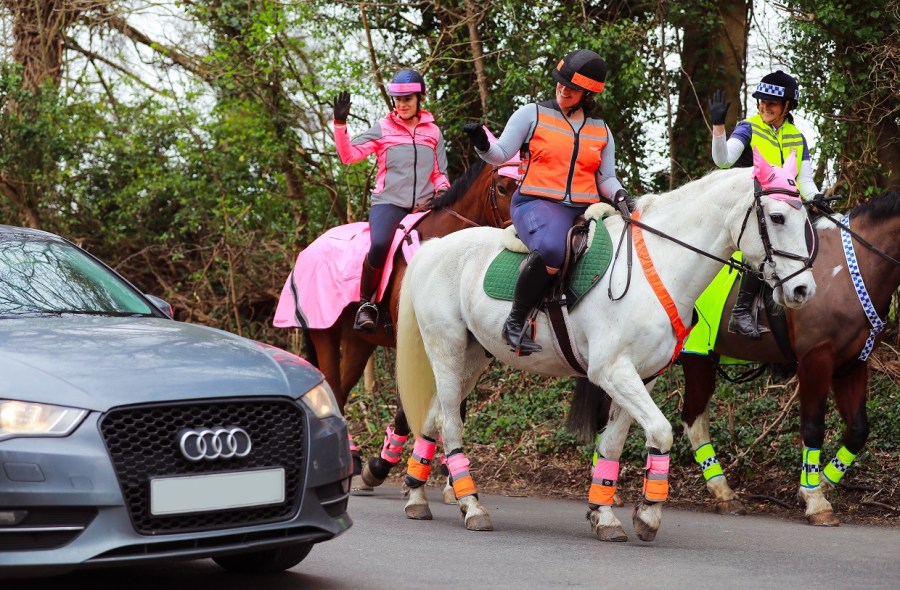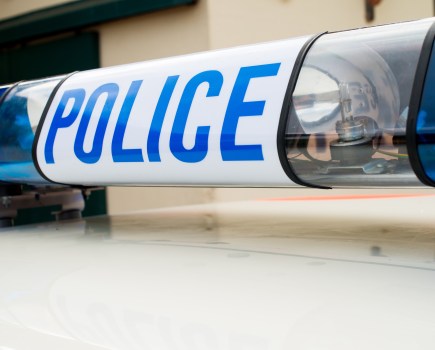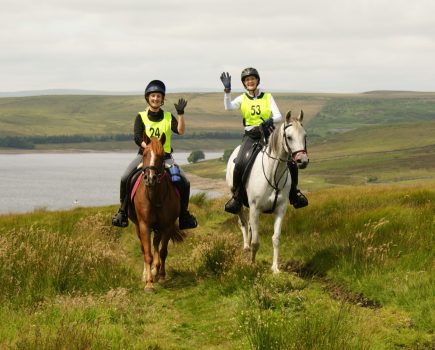Operation Snap is a quick and easy way to report road incidents while hacking a horse to the police, but more horse riders need to make use of it. In order to submit a report, you must upload video footage of the incident, which means always wearing a camera when you ride — and not enough horse riders are doing this either.
In a survey by the Pass Wide and Slow Facebook group, 45% of riders said that they don’t use a hat or body camera when riding on the roads. Cost was cited as a key reason for not using one.
“When reporting an incident, it is important to remember as much information as possible, including noting down the description of the driver and the vehicle.
“We appreciate that it is not always possible to remember the details after an incident on the roads, which is why more riders are choosing to wear a head or body camera when out riding,” said a spokesperson for the British Horse Society (BHS).
“Taking these steps could make a difference to the outcome of an investigation and potential prosecution.”
Have you heard of Operation Snap?
When I asked our #Hack1000Miles challengers whether they have ever used Operation Snap to report an incident while riding on the roads, well over half said that they had never heard of it. Just 16% of respondents said that they are aware of Operation Snap, while only 15% have used it to report an incident.
These figures are a concern. Every single rider is united in a desire to feel safe(r) when riding on the road — most of us have no choice but to use them to get to and from bridleways.
Making better use of Operation Snap is a key way of achieving this, because ultimately it can (and does) lead to drivers being educated (and possibly given a warning, or worse) about how to pass horses safely and correctly on the road.
How to use Operation Snap
If you experience an incident while riding on the road, you need to report it immediately to the local police force that covers the area where it occurred. Bear in mind that if your horse is kept at livery, or you have ridden a long distance, this may not be the same police force that covers where your home is.
Operation Snap has an online form for people to report an incident and submit evidence. Other road users can use it too, including drivers and cyclists. To find it, visit the website for your local police, or search its name and the words ‘Operation Snap’ on Google. Mandatory details you need to provide include:
- Your name, address and contact details
- Location, date and time of the incident
- Registration number of the offending vehicle, as well as its make and colour
- A written description of what happened
- Whether you are prepared to go to court should things progress that far
- Footage from a camera.
Video footage
Video footage from a body or hat camera must be unedited and not shared on social media. Choose as good a quality camera as you can afford (the higher the number of pixels the better, as it needs to clearly show identifying features such as a vehicle registration number).
You should keep video footage on your device after uploading — don’t delete it. The finer details of what is required varies from force to force, so read the instructions carefully. Devon & Cornwall Police requires two minutes of hat cam footage either side of the incident, for example, whereas Northamptonshire Police doesn’t specify this on its form.
The more footage the police prosecutor has to watch, the easier it is for them to get a full understanding of the incident. If you can, submit your report the same day the incident occurs.
Officers have an obligation to inform drivers of the offence they have committed within 10 days, and you need to factor in time for your report to be viewed by the police first. There is then a six-month time limit for prosecutions.
Police action
Reporting road incidents to the police is a simple yet effective way that riders can work together to help make the roads safer for riding or driving horses. Educating drivers is crucial, and a successful report via Operation Snap can lead to warnings or mandatory attendance on an educational course for drivers.
Don’t scoff at this (many riders do). I imagine that an official letter from the police warning someone about their actions while driving and the risk of further action being taken is quite a worry for a person to receive.
Most drivers are not bad people — many have absolutely no clue how to pass a horse safely, and why not doing so is so dangerous.
Next time, the hope is that they will brake a bit earlier, slow right down and give the horse plenty of room. Of course, there are unscrupulous individuals who seem to believe the rules (and the law) doesn’t apply to them.
In these cases, we have to trust in the system. Keep videoing and keep reporting to Operation Snap. Eventually, they will be caught.
Incidents worth reporting
An ‘incident’ isn’t just a vehicle striking a horse. Passing too close and too fast, as well as aggressive behaviour (such as swearing, using hand signals, stopping and getting out of the car threatening to hurt a rider), should be reported too.
There were 45 incidents involving horse riders reported to West Yorkshire Police between July and September 2023. Of these, 20 drivers were found to have driven without reasonable consideration to others, while three had driven without due care and attention.
All 23 drivers had to attend an educational course. No further action was taken concerning the remaining incidents due to a lack of evidence.
That’s a 50% success rate. Think of it as 20 more drivers on the road who have a better idea (and extra motivation) of how to be careful the next time they see a horse rider on the road.
For now, it’s a lot better than nothing. Long term, more reports need to be made to Operation Snap so that the number of drivers being educated increases.
What the police say
“The police alone can’t be everywhere all of the time and so by enabling the public to be our additional eyes and ears we can help to deter dangerous and reckless behaviour,” says detective chief superintendent Andy Cox from the Metropolitan Police.
“We review submissions from dashcam and helmet cameras and, where appropriate, will take action which can and has led to offenders being disqualified from driving.”
Lincolnshire Police confirmed that every single submission to Operation Snap is viewed, and where the footage shows a traffic offence action is taken. This means that evidence in the form of good-quality video footage is essential, and hat cams are fast becoming a critical piece of riding kit that every rider on the road should have.
The National Police Chiefs’ Council (NPCC) has also been working with the BHS around road safety. Data collated by the BHS has led to mounted police patrols on stretches of road that are hotspots for horse riding incidents.
Urgent action required
Remember there were 3,383 road incidents involving horses reported to the BHS in 2023. Out of these, three people and 66 horses died, while 94 people and 86 horses were injured.
This is despite the changes to the Highway Code coming into force in January 2022. The updated guidelines state that other road users should pass a horse rider or carriage driver leaving at least 2m between their vehicle and the horse in question, and that they should go no faster than 10mph past an equine.
Yet last year’s BHS figures show that 85% of incidents occurred because a vehicle passed the horse too quickly or too closely. Additionally, 23% of riders fell victim to road rage or abuse from motorists. View the full story.
“Too many drivers underestimate the importance of driving carefully around horses,” says BHS director of safety Alan Hiscox, who writes an exclusive column for Your Horse Online. “This is detrimental to the safety of equestrians. You only have to look at the two horses who were tragically killed in the space of just two weeks at the beginning of 2023.
“Our fear is that guidelines aren’t being clearly explained and delivered; this needs to change. Urgent action is required to make every road user aware of the Highway Code changes and, critically, why it’s so important to pass horses with care. Only through working collaboratively to educate and drive awareness will we be able to stop these awful incidents from happening over and over again.”
Report incidents to the BHS
After reporting to the police, riders should also submit details of an incident or near miss to the BHS. This won’t lead to police action being taken — which is why reporting to the police via Operation Snap first is imperative — but it does generate important data.
This data has helped the BHS identify stretches of road that are hotspots for riding incidents; for example, leading to new road signs and mounted police patrols. Increasing the number of incidents that are logged via Horse i remains a key priority for the BHS in 2024.
“Data is critical to the work we do to lobby for change in safety laws and it played a vital role when it came to informing the changes to the Highway Code for equestrians,” explains Alan.
“Collating this data also allows us to better understand the rate of equine-related incidents and, ultimately, ensure that horses remain safe, as well as those around them.
“It helps us to identify key locations across the country where incidents regularly occur, meaning that we can target our work to help make these locations safer.”
Anyone can report an incident or a near miss to the BHS — you don’t even have to be a member. You can do so via the charity’s online form, or by downloading the Horse i app via the Apple Store or Google Play on your mobile phone or tablet. Find out more.
My near miss with a lorry
Sometimes, a vehicle passing inappropriately is heavily branded with a company name and logo, giving you another channel to report the driver. This happened to me while hacking my ex-racehorse King on a B road through Stratton Audley in Oxfordshire.
It is a country road with a 60mph limit, narrow enough not to have white lines down the middle but wide enough that two vehicles can just about pass each other comfortably.
I was on my way home from a nice hack when an enormous articulated lorry came zooming around the bend and didn’t even attempt to slow down in order to pass us. The driver had plenty of time to see us.
We were in high vis and way back from the bend when he came into view. Yet he chose not to slow down and he was going FAST. There was a large ditch to my left, which meant I had nowhere to go.
In hindsight, I should have turned King around to face away from the lorry so that if he spooked, he was more likely to leap forward rather than spin — reducing the likelihood of me falling off and also lowering the risk of him slipping. (Metal shoes on a tarmac surface is not ideal.)
What I actually did, however, was grab the neck strap (probably get a bit tense in my body — bad move when I need to convey confidence to my horse) and say, “Oh *beep*”.
Taking further action
Do you know what my brilliant horse did? Absolutely nothing. He didn’t even flick an ear. He just carried on walking along his side of the road thinking (I guess) how much he was looking forward to eating his haynet when he got home. King held my hand that day!
Armed with video footage, I immediately sent it off to the lorry company along with a polite, but firm, email explaining exactly how and why their driver had endangered my life that day (and King’s) and to please educate their drivers on how to pass horses in the future.
I received a reply later that week apologising, and stating that the driver had been identified and giving a warning. Did it work? I don’t know, I’ve not seen the lorry since. But I’m glad I did something.
I confess that I didn’t report this incident to the police. If Operation Snap existed then, I hadn’t heard of it. If it were to happen tomorrow, you can count on me uploading my footage and reporting it to them as soon as I get home. I did, however, log the incident with the BHS via their online form.
The key message
Every one who owns and/or rides horses has a duty to wear a camera out riding and report every incident we experience to the police and the BHS. That means you, and me — plus all our horsey family and friends.
Spread the message of pass wide and slow to everyone you know. Share social media posts about horses and riders being injured and killed on the road on your own page so that your non-horsey friends see it.
Make them aware of the consequences their actions could have. Ultimately, there is a long way to go to make roads safer for horse riding, and all riders need to stand together to try and make it happen.
Related content
- Hat cameras for horse riders: what to look for and 6 on the market
- The Highway Code: a solicitor explains what it means for horse riders
- Horse rider road safety: things you can do to help make the roads safer
- Alan Hiscox: seeing your horse badly injured on the road is something you never forget
- ‘I wish it was me who broke a leg, not you’: rider speaks out after pony is killed on the road









